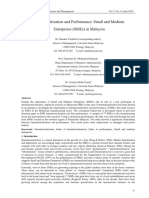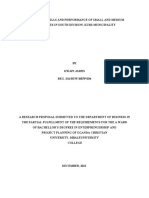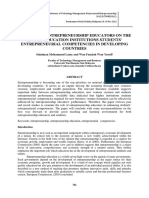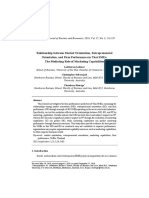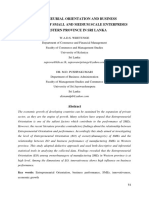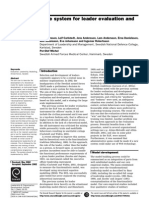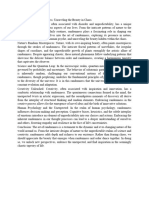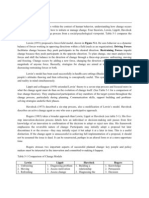Jurnal Fenomenologi
Jurnal Fenomenologi
Uploaded by
Reins 'Samudera Merah'Copyright:
Available Formats
Jurnal Fenomenologi
Jurnal Fenomenologi
Uploaded by
Reins 'Samudera Merah'Original Description:
Copyright
Available Formats
Share this document
Did you find this document useful?
Is this content inappropriate?
Copyright:
Available Formats
Jurnal Fenomenologi
Jurnal Fenomenologi
Uploaded by
Reins 'Samudera Merah'Copyright:
Available Formats
www.ccsenet.
org/ijbm
International Journal of Business and Management
Vol. 6, No. 6; June 2011
The Measurement of Entrepreneurial Personality and Business
Performance in Terengganu Creative Industry
Muhammad Abi Sofian Abdul Halim
Faculty of Business Management, Universiti Teknologi MARA
21080 Kuala Terengganu, Terengganu, Malaysia
Tel: 60-13-920-4322
E-mail: abisofian@tganu.uitm.edu.my
Associate Professor Dr Shaladin Muda
Faculty of Business and Economics, Universiti Malaysia Terengganu
21300 Kuala Terengganu, Terengganu, Malaysia
Tel: 60-19-934-6600
E-mail: shaladdin@umt.edu.my
Associate Professor Dr Wan Abd Aziz Wan Mohd Amin
Faculty of Business and Economics, Universiti Malaysia Terengganu
21300 Kuala Terengganu, Terengganu, Malaysia
Tel: 60-19-988-5293
Received: October 27, 2010
E-mail: wanabdulaziz@umt.edu.my
Accepted: December 9, 2010
doi:10.5539/ijbm.v6n6p183
Abstract
As the Terengganu creative industry grows from the producing sector into more complexes in industrialization,
entrepreneurship will draw more attention to the need for emphasizing on creative industry. There is a vast of
view to measure the factors which are affected to the growth of business performance. Thus, entrepreneurial
personality becomes as a variable which have a relationship to the business performance in Terengganu creative
industry. Malaysia Handicraft Development (Kraftangan Malaysia) is a government agency that taken
responsibility to assists creative entrepreneurs in developing entrepreneurial characteristic and improving the
business performance. According to previous literatures, several factors of entrepreneurial personality are
strongly contributed to the performance of small and medium business in creative industry, such as; need for
achievement, locus of control, creativity, innovative and also strategy to grab market opportunities. Therefore,
the purpose of this paper is to measure the relationship of entrepreneurial personalities and business performance
among Terengganu creative entrepreneurs who are engaged with the Kraftangan Malaysia, as well as in
Terengganu branch. The output reveals that the result of this study is statistically significant with moderate
correlation in a relationship of entrepreneurial personality and business performance. However, the partial
correlation reveals that the moderating of government initiative is slightly lower correlated toward the relation of
entrepreneurial personality and business performance. Finally, this study implicated two matters that should be
concerned by Terengganu creative entrepreneurs once to become as a satisfaction creative entrepreneurship,
there are; desire to transform the conventional thinking into a new paradigm, and; attempt to change the culture
of life.
Keywords: Entrepreneurial personality, Business performance, Creative industry, Creative entrepreneurs
1. Introduction
The importance of entrepreneurial personality toward business performance is well recognized, as reflected an
increasing number of studies devoted to entrepreneurship in recent years, for example; Shane et al, 2003;
Llewelly et al, 2003; Littunen, 2000; Gartner, 1990; Bird, 1998; and McClleland, 1961. These prior studies have
largely addressed what affected entrepreneurial personality and how it occurs. However, in order to develop
Published by Canadian Center of Science and Education
183
www.ccsenet.org/ijbm
International Journal of Business and Management
Vol. 6, No. 6; June 2011
entrepreneurial personality as empirical study in Malaysia Handicraft development Agency (Kraftangan
Malaysia) that subsequently allows appropriate intervention from this agency perspective, it is necessary to
further investigate the attributes involved in entrepreneurial personality through a framework which has close
connections with business performance.
The creative industries are a new practicing in Malaysia to establish in several sector, and which relate to the
needs of idea to develop arts-making through entrepreneurship. It provides a unique opportunity for designers,
artists, filmmakers, researchers, educators and entrepreneurs to easily connect and collaborate with others to
create new work and develop new product ideas in creative industries. However, most of Malaysia creative
entrepreneurs are not really achieving personality traits in a context of entrepreneurship. In fact, some of them
are not really confident to face challenges in creative industry. Additionally, there are still depending on the
government initiative to assists the product selling, financial, operation and also guiding in their business
management (Hatta Azad Khan, 2006).
Therefore, the purpose of this paper is first; to identify the significant relationship of entrepreneurial personality
toward the business performance, and secondly; is to study the significance of government initiative as a
moderator in a relationship of entrepreneurial personality and business performance. Meanwhile, the scope of
this study is to measure the factors in entrepreneurial personality toward the significance relation with the
business performance among Terengganu creative entrepreneurs who are registered with Kraftangan Malaysia,
Terengganu.
2. Entrepreneurial Personality in Terengganu Creative Industry
The definition of entrepreneurial personality refer to the individual who have the ability to take risk,
innovativeness, knowledge of the market functions, marketing skills and business management skills; which are
influence to the personality traits in a context of cooperation, networking, and also independent in business
(Littunen, 2000). Meanwhile, the term of entrepreneurial personality in this study describe the individual who
are highly motivation in a factor of; need for achievement, locus of control, creative, innovative and grab market
opportunities (Stevenson & Gumpert, 1983; McClleland, 1961; Shane et al, 2003; Rotter, 1966). Nevertheless,
recent research showed that the creative entrepreneurs are much more artistic and creativity reliant than other
factors in entrepreneurial characteristics (Ghouse, 2008). As well as to develop the creative entrepreneurs toward
idealistic, innovation and strategic, Kraftangan Malaysia, Terengganu has taken responsibility to accommodate
facilities, technology, and workshop training program. The aim of this agency is to develop the skill and sense of
entrepreneurship among creative entrepreneurs in Terengganu, in term of innovative, creative, independent, risk
taking, and problem solving.
Previously, creative industry become as a main sector in United kingdom which is contributed to the gross
domestic product in economy, where the growing rate is faster than any other economic sector in a year of 1997
to 2003 (Einarsson, 2002). Terengganu has vast of cultural and creative resources in the fields of performing arts,
visual and fine arts, Islamic calligraphy, film, arts education, literary works and craft which can be further
developed and exploited as well as in United Kingdom. Ministry of Unity, Arts, Culture and Heritage takes
responsibility to ensure the implementation of creative industry in Malaysia becomes reality (Rais Yarim, 2006).
Therefore, an emphasizing of entrepreneurial characteristic in a Malaysia, particularly Terengganu creative
industry becomes essential in developing personality traits which is contributed to the business performance.
3. The Indicators and Variables
Entrepreneurial personality can be seen as underlying characteristic that are causally related to effective business
performance (Litunen, 2000). It is a multi-dimensional construct constituted from different components, such as;
need for achievement (McClleland, 1961), locus of control (Rotter, 1966), creativity (Marcus, 2005), innovative
(Littunen, 2000) and grab market opportunities (McClleland, 1961). Table 1 represents indicators for each
variable in entrepreneurial personalities which are key factors affecting the development of business
performance. Furthermore, government initiative became as a moderating variable to study the significance
changing toward the association of entrepreneurial personality and business performance.
4. Hypothesis and Theoretical Framework
The first aim of this study is to investigate whether a better personality in entrepreneurship will affect to business
performance or vice versa. Based on these theoretical starting points, the first research hypothesis is framed as
follows;
H1: There would be a significance relationship between entrepreneurial personality and business performance.
Furthermore, this study also investigates the role of government initiative as a supportive action to the
184
ISSN 1833-3850
E-ISSN 1833-8119
www.ccsenet.org/ijbm
International Journal of Business and Management
Vol. 6, No. 6; June 2011
association of entrepreneurial personality and business performance. Therefore, the second hypothesis is framed
as follows;
H2: There would be a significant changing between entrepreneurial personality and business performance if
government initiative become as a moderator.
As well as to discuss the hypothesis of this study, the theoretical framework becomes essential to visualize the
combination of independent variables, dependent variable, and moderating variable in developing of two
hypothesis. Figure 1 represents the relationship of factors of entrepreneurial personality (e.g. need for
achievement, creativity, innovative, locus of control, and grab market opportunities), business performance, and
government initiative.
5. Methodological
Since this study is aimed at addressing the phenomenon of entrepreneurial personality affected to the business
performance, a quantitative approach with designing of questionnaire was adopted so that investigating the
variables was made possible.
As part of this study is involved several crafts products in Kraftangan Malaysia, Terengganu (e.g. batik, ceramics,
wood carving, forest based craft, metal, and songket), researcher has used the stratified random sampling to
clarified each of creative products in the total populations. Around 309 local creative entrepreneurs have been
registered under Kraftangan Malaysia, Terengganu and have trained a wide range of entrepreneurship.
Meanwhile, there are 107 set of questionnaire was distributed to the creative entrepreneurs in Terengganu.
However, there are only 105 respondents were replied the questionnaire represented a diversity of product
categories. Then, the data was entered and analyzed with the Statistical Package for Social Sciences (SPSS)
software program (version 16.0). Table 2 shows the number of population and sample in this study.
6. Data Analysis and Finding
As part of this research is to study the significance relationship between variables in theoretical framework,
bivariate correlation was used to test the H1 and partial correlation used to test the H2 in this study. However, a
descriptive analysis was first conducted before inferential analysis in order to analyses the frequency and
percentage of demographic in entrepreneurial and business profile. Furthermore, this analysis was divided into
four parts, including; the reliability analysis, descriptive analysis on demographic profile, the relationship of
entrepreneurial personality and business performance (H1), and government initiative as a moderating variable
in a relationship of entrepreneurial personality and business performance (H2).
6.1 Reliability Analysis
Based on the reliability analysis, it indicates that most of the variables that has been investigated in this study are
found to be highly reliability, such as; need for achievement (0.822), locus of control (0.761), creativity (0.785),
innovative (0.796), grab market opportunities (0.816), business performance (.0939) and government initiative
(0.950), as well as mention in a table 3. It means that the structure of questionnaire in this study is well
consistence. Table 3 shows the result of reliability of this study.
6.2 Descriptive Analysis on entrepreneurial Profile
A frequency and percentage of respondents in each part of entrepreneurial profile was depicted in table 4
(demographic profile) and 5 (business profile). In term of demographic profile, most of creative entrepreneurs in
Kraftangan Malaysia Terengganu are age in between 31 - 45 (43.8%) and follow by age of 46 55 (29.5%) and
the rest are below 20%. In term of gender, the majority of creative entrepreneurs are male (61%) and female
(39%). Meanwhile, marital status has shown that is 78.1% are married, 12% are widow and only 10.5% are
bachelor. Those operating in creative business form, the majority of their field study are business background
(58.1%), arts (35.2%), social science (4.8%), and science and technology (1.9%). In term of level of education,
the highest contribution is from school which equal to 34.3%, and followed by certificate holder (27.6%),
diploma holder (26.7%), degree holder (10.5%) and master/PhD holder (1.0%).
In term of business profile, the result in Table 5 clearly shows that the majority of creative entrepreneurs who are
registered in Kraftangan Malaysia Terengganu are those operated their business in city area (55.2%), followed by
town area (38.1%), and village (6.7%). In term of business types, there are 60.0% of total respondents are
involved in sole proprietorship, 24.8% are involved in private limited, and only 15.2% are operated in
partnership. Meanwhile, the market size has shown that most of respondents marketed their product in a stated
level (44.0%), followed by national level (36.0%), district level (17.0%) and only 3.0% for international level.
Furthermore, the term of operations has indicated that 42.9% of respondents are operated in between 11 20
Published by Canadian Center of Science and Education
185
www.ccsenet.org/ijbm
International Journal of Business and Management
Vol. 6, No. 6; June 2011
years of operations, 23.8% in between 6 10 years, 21.0% are operated more than 21 years, and only 12.4% are
operated less than 5 years. In term of types of products producing, the highest level of product producing is a
batek product (31.4%), followed by silver product (14.0%), 13.0% for wood carving, forest-based, pewter, and
songket, 3.0% for crystal, 2.0% for ceramic, and 1.0% for leather. All results are shown in table 5 below.
6.3 Hypothesis 1: Relationship of entrepreneurial personality and business performance
Entrepreneurial personality become as a major independent variable which comprises five minor supportive
variables (e.g. need for achievement, locus of control, creativity, innovative, grab market opportunities) to looks
the significance relationship with the business performance. Generally, the first conducted of this analysis is to
test the hypothesis 1, and followed by the measurement of correlation of each factors in entrepreneurial
personality toward business performance.
The results indicate that there was a statistically significant association between entrepreneurial personality
(major independent) and business performance with r=0.649 and p=0.000. The output reveals that the results of
this study are moderately significance relationship. Therefore, we accept the hypothesis and also can be
interpreted that most of entrepreneur in Kraftangan Malaysia Terengganu are moderately have a sense of
entrepreneurship which are contributed to the business performance. These results also supported the literature of
this study as claimed by Littunen (2000), McClelland (1961), Rotter (1966), Marcus (2005), Drucker (1988),
Bird (1989), and Bechetti & Trovoto (2002).
Additionally, there are only two factors of entrepreneurial personality indicate that are moderate correlation with
business performance, there are; grab market opportunities (r=0.564, p=0.000) and Locus of Control (r=0.563,
p=0.000), However, others factors of entrepreneurial personality are not really strong exist but still have a
relationship, such as; innovative (r=0.482, p=0.001), creativity (r=0.451, p=0.005), and need for achievement
(r=0.376, p=0.042). Table 6 mentions the results of coefficient correlations and significance value.
6.4 Hypothesis 2: Government initiative as a moderating variable
Kraftangan Malaysia is a Malaysian government agency which is under Ministry of Unity, Information and
Culture. Kraftangan Malaysia Terengganu is a departments of this agency which is responsible to develop the
creative industry in Terengganu, such as; human capital development, industrialization, technology development,
and also entrepreneurship. Therefore, Kraftangan Malaysia Terengganu plays an importance role to realize the
development of entrepreneurship in Terengganu creative industry. Consequently, an initiative of government
become as a moderating variable in this study to measure the effective action that has been done by government
toward the development of entrepreneurial personality and business performance.
The findings indicate that moderating of government initiatives (Kraftangan Malaysia) was statistically
significant in an association of entrepreneurial personality and business performance with r=0.438 and p=0.000.
Therefore, the result of hypothesis 2 appears that the moderating of government initiative is weakly moderate in
the relationship of entrepreneurial personality and business performance; however, it is still significance. This
finding also agreed with the argument of previous literature, as claimed by; Wan Hashim Wan The (1995), Rais
Yatim (2006), and Hatta Azad Khan (2006). Furthermore, these findings also supported by the result of
diminished significance relationship of variables, such as; locus of control (r=0.446, p=0.002), innovative
(r=0.304, p=0.006), need for achievement (r=0.224, p=0.037) and also creativity (r=0.293, p=0.043). However,
the factor of grab market opportunities (independent variables) is keep in existence in the similar results as
hypothesis 1 (r=0.564, p=0.000). All results are shown in a table 7.
Furthermore, these findings can be interpreted that some of creative entrepreneurs in Terengganu have not taken
the opportunities that was accommodated by Kraftangan Malaysia Terengganu, such as; entrepreneurship
training and development, business facilities, financial assistance, business chain, and marketing. In fact, some
of them are never known the opportunities that were offered by government previously (Wan Hashim Wan The,
1996). In addition, Rais Yatim (2006) was mentioned that some of creative entrepreneurs are still depending on
others government ministries (e.g. Ministry of Entrepreneurship Corporation Development, Ministry of Rural
Area development) which are contribute to the entrepreneurial policies planning, business assisting, and legal
action of creative industry.
7. Implication and Recommendation
Currently, arts-making has been defined as activities which are highly contributed to the business opportunities
as well as in creative industry (Wan Hashim Wan The, 1996; Hatta Azad Khan, 2006; Rais Yatim, 2006).
Additionally, an initiative of Malaysia government become a platform for those practitioners to develop their
entrepreneurial personality toward business performance, such as; need for achievement, locus of control,
186
ISSN 1833-3850
E-ISSN 1833-8119
www.ccsenet.org/ijbm
International Journal of Business and Management
Vol. 6, No. 6; June 2011
creativity, innovative, grab market opportunities. According to the result of hypothesis 1, the relationship of
entrepreneurial personality in Kraftangan Malaysia Terengganu has a moderate correlation toward the business
performance (r=0.649, p=0.000). However, hypothesis 2 has shown that most of Terengganu creative
entrepreneurs are not really aware the opportunities that was offered by government. Therefore, these findings
implicated that are two matters should be concerned by Terengganu creative entrepreneurs once they want to
become a qualified creative entrepreneurs; there are; desire to transform the conventional thinking into a new
paradigm, and; attempt to change the culture of life.
7.1 Desire to shift the conventional thinking into an entrepreneurial paradigm
As well as to embracing the creative industry become competitive, the practicing of paradigm shift in
entrepreneurship become as a factor to influencing creative industry to become growth, sustainability and
organizational development. The major focus of creative entrepreneurs is the issue of entrepreneurial personality
development which shifting their paradigm in business perceptions. Certainly, creative entrepreneurs should shift
their paradigm from artistic-based performance into entrepreneurial-based performance to activate their business
performance and also to explore the creative industry as a major contribution to Malaysian economy. Therefore,
Terengganu creative entrepreneurs also should take initiative to develop their own personality traits in term of
capable to take challenging task, problem solving, self-confidence, ability to influence events, capable to study
market environment, and also creating a new business strategic.
This implication also agreed with the argument by Wan Hashim Wan Teh (1996), Hatta Azad Khan (2006), and
Rais Yatim (2006) who was mentioned that creative entrepreneurs need to shift their paradigm to become
entrepreneurial traits, in term of profit-oriented and competitive-oriented. According to table 8 (Paradigm shift of
creative entrepreneurs in creative industry) that was highlighted by Wan Hashim Wan Teh (1996), Hatta Azad
Khan (2006), and Rais Yatim (2006), there are six indicators that should aware by creative entrepreneurs in
entrepreneurial paradigm, such as; independently, motivated in arts and business, product focus on customers
appreciation, creative and innovative, profit oriented, and product-value depending on customer perceptions.
7.2 Attempt to change the culture of life
According to Hatta Azad Khan (2006), some of Malaysian creative entrepreneurs are not realize their thinking
toward the vision and mission of the business, strategic planning, develop competitive advantage, and the market
characteristics. In other words, there are ignoring the achievement of their business in a context of looking a
better business improvement, challenging, and set the target. Furthermore, this result implicate that creative
entrepreneurs should change their business culture in a context of business value, thinking and believing. The
practicing of cultural changing in a business management is to change the business philosophy which is directly
affected to the vision, planning, and implementation of business strategic. Schaefer (1989) has highlighted that
the study of cultural change in sociology included the changing of values of thinking, ideas, customs, and social
system of community in their life. The changing concept of business culture in this study is to change the culture
of self-satisfaction toward the business into customer satisfaction. Therefore, the finding of this study has
implicated that Terengganu creative entrepreneurs should attempt to change of their culture of life in a context of
thinking, value, believing, and custom.
8. Conclusion
In summary, the term of entrepreneurial personality of this study discovered several personality traits, such as;
need for achievement, locus of control, creative, innovative, and grab the market opportunities. This quantitative
analysis reveals that the factors of entrepreneurial personality are significance associated with the business
performance. Consequently, the significance results have suggested that the creative entrepreneurs should shift
their paradigm to become more entrepreneurial characteristics and also change their culture in a context of
art-based performance into entrepreneurial- based performance. Beside that, creative entrepreneurs should
change their culture of life to become more on profit and customer oriented.. Therefore, the result of this study
can be realize that a good creative entrepreneurs is individual who are ability take challenge, competitive,
strategic and highly desire in business achievement.
Furthermore, government also should take initiative to specified and structure their policies in development of
entrepreneurial personality, as well as that they have implemented in developing of entrepreneurial skill and
knowledge in an entrepreneurial development program previously. Therefore, the solution and finding of this
study will applicable to a wide range of creative industry in Malaysia that can increase the level of activities in
arts field into a new dimension.
Published by Canadian Center of Science and Education
187
www.ccsenet.org/ijbm
International Journal of Business and Management
Vol. 6, No. 6; June 2011
References
Becchetty, L., & Trovato, G. (2002). The Determinants of Growth for Small and Medium Sized Firm. The Role
of the Availability of External Finance. Small Business Economics, 2(4), 53-65
Bird, B. (1989). Entrepreneurial Behavior. London: Glenview.
Einarsson, A. (2002). Entrepreneurship as a Part of the Creative Industries within the Cultural Sector in a Small
Society. Review of International Comparative Management, 1(13), 208-229.
Gartner, W.B. (1990). Some Suggestions for Research on Entrepreneurial Traits and Characteristics.
Entrepreneurship Theory and Practice, 5(2), 15-28.
Ghouse, N. M. (2008). Seni Tempatan Wajar Memasuki Babak Industri, Ceramah Pesona Seni Aswara di Aswara,
Kuala Lumpur.
Hatta Azad Khan. (2006). Creative and Cultural Industries in a Context of Globalization. Procedding paper for
Conference of Cultural Arts, Heritage and Arts Education in 21st. Century: Theory and Practice, PWTC, Kuala
Lumpur.
Littunen, H. (2000). Entrepreneurship and the Characteristics of the Entrepreneurial Personality. International
Journal of Entrepreneurial Behavior & Research, 6(6), 103-121.
Llewellyn, D.F., & Wilson, K.M. (2003). The Controversial Role of Personality Traits in Entrepreneurial
Psychology. Journal of Education and Training, 45(6), 96-123.
McClelland, D.C. (1961). Characteristics of Successful Entrepreneurs. Journal of Creative Behavior, 21(3),
53-67.
Rais Yatim. (2006). Ministry of arts, Culture and Heritage: Keynote address in Opening Ceremony of
Conference of Cultural Arts, Heritage and Arts Education in 21st. Century: Theory and Practice, PWTC, Kuala
Lumpur.
Rotter, J. B. (1966). Generalized expectancies for internal versus external control of reinforcement. Psychological
Monographs: General and Applied, 80(1), 1-28.
Schaefer, R.T. (1989). Sociology. New York: McGraw-Hill
Shane, S., Locke, E.A., & Collins, C.J. (2003). Entrepreneurial Motivation. Human Resources Management
Review, 13(5), 86-102.
Stevenson, H. (1983). A Perspective on Entrepreneurship. Harvard Business School Working Paper, 9(21),
384131.
Wan Hashim Wan The. (1996). Malay Handicraft Industries: Origins and Development. Kuala Lumpur: Dewan
Bahasa & Pustaka.
188
ISSN 1833-3850
E-ISSN 1833-8119
www.ccsenet.org/ijbm
International Journal of Business and Management
Vol. 6, No. 6; June 2011
Table 1. Indicators for each variable
Variables
Indicators
Need for
i.
Achievement
ii. Capable to challenging task
Citation
Looking for a better improvement
Littunen, 2000;
McCleland, 1961
iii. Set the target through own effort
iv. Problem Solving
Locus of Control
i.
Capable to control ones own life
Rotter, 1966;
ii. Self-confidence
Littunen, 2000
iii. Ability of entrepreneurs to influence events
iv. Capable to turning thoughts into action
Creativity
Creativity is the key value of entrepreneurship
Marcus, 2005
Capable to develop new product
Capable to differentiate product
Create strategic planning and implementation
Innovative
i.
Develop current product performance
Littunen, 2000;
ii. Develop current production
Bird, 1989;
iii. Create new source of supply
Drucker, 1988
iv. Create new structure in management
Grab Market
Capable to study market environment
Opportunities
Strong character to face competitors
McClelland, 1961
Strategic to grab opportunities based on strength
Business
i.
Business growth
Performance
ii. Profitability
Bechetti & Trovoto.
2002
iii. Competitive advantage
iv. Manageable
Government
i.
Policies making
Hatta Azad Khan, 2006;
Initiative
ii. Business assisting
Wan Hashim Wan Teh,
iii. Legal and Act
1996
Table 2. Population and sample size
Producers
Population
Frequency
Batik
Sample
Replied
97
31.2
33
33
1.8
Wood Carving
37
12.1
13
13
Forest based fiber
37
12.1
13
13
Pewter
37
12.1
13
13
Songket
37
12.1
13
13
Silver
40
13.0
14
14
Crystal
2.8
Leather
2.8
309
100.0
107
105
Ceramic
Total
Published by Canadian Center of Science and Education
189
www.ccsenet.org/ijbm
International Journal of Business and Management
Vol. 6, No. 6; June 2011
Table 3. Reliability Analysis of Variables
Section
Number
of Cases
Number
of Item
Reliability
Coefficients
ALPHA
Need for Achievement
105
13
0.822
Locus of Control
105
12
0.761
Creativity
105
18
0.785
Innovative
105
13
0.796
Grab Market Opportunities
105
12
0.816
Business Performance
105
30
0.939
Government Initiative
105
15
0.950
Table 4. Demographic Profile
Items
Frequency
Percentage
Gender
Frequency
Percentage
Level of Education
Male
64
61.0
School
36
34.3
Female
41
39.0
Certificate
29
27.6
105
100.0
Diploma
28
26.7
Degree
11
10.5
1.0
105
100.0
61
58.1
Science & Tech
1.9
4.8
Total
Marital Status
Bachelor
11
10.5
Master/PhD
Married
82
78.1
Total
Widow
12
11.4
Field of Study
105
100.0
Total
Age
Below 18
Business
1.9
Social Science
19 - 30
10
9.5
Arts
37
35.2
31 - 45
46
43.8
Total
105
100.0
46 - 55
31
29.5
56 above
16
15.2
105
100.0
Total
190
Items
ISSN 1833-3850
E-ISSN 1833-8119
www.ccsenet.org/ijbm
International Journal of Business and Management
Vol. 6, No. 6; June 2011
Table 5. Business Profile
Items
Frequency
Percentage
Area of Location
Items
Frequency
Percentage
Less than 5 years
13
12.4
Term of Operation
Village
6.7
Town
40
38.1
6 10 years
25
23.8
City
58
55.2
11 20 years
45
42.9
Total
105
100.0
More than 21 years
22
21.0
105
100.0
33
31.4
1.9
Wood Carving
13
12.4
Forest Based Fiber
13
12.4
Type of Business
Total
Sole Proprietorship
63
60.0
Type of Product
Partnership
16
15.2
Batek
Private Limited
26
24.8
Ceramic
105
100.0
Total
Market Size
District
18
17.1
Pewter
13
12.4
State
46
43.8
Songket
13
12.4
National
38
36.2
Silver
14
13.3
2.9
Crystal
2.9
105
100.0
Leather
1.0
105
100.0
International
Total
Total
Table 6. Coefficient Correlations and Significance Value
Independent Variables
Significance
Bivariate
Correlation
Level of Correlation
Need for Achievement
0.042
0.376
Weakly moderate
Locus of Control
0.000
0.563
Moderate
Creativity
0.005
0.451
Weakly moderate
Innovative
0.001
0.482
Weakly moderate
Grab Market Opportunities
0.000
0.564
Moderate
Significance
Partial
Correlation
Level of Correlation
Need for Achievement
0.037
0.224
Very weak moderate
Locus of Control
0.002
0.466
Weakly moderate
Creativity
0.043
0.293
Very weak moderate
Innovative
0.006
0.304
Weakly moderate
Grab Market Opportunities
0.000
0.564
Moderate
Table 7. The Partial Correlation Result
Independent Variables
Published by Canadian Center of Science and Education
191
www.ccsenet.org/ijbm
International Journal of Business and Management
Vol. 6, No. 6; June 2011
Table 8. Paradigm shift of creative entrepreneurs in Malaysia creative industry
Conventional Thinking
Entrepreneurial Paradigm
(Artistic-based Performance)
(Entrepreneurial-based Performance)
1. Dependent
1. Independent
2. Arts motivated
2. Business and art motivated
3. Self-appreciation
3. Consumer-appreciation
4. Creative
4. Creative & Innovative
5. Social oriented
5. Profit oriented
6. Product value depend on producer
6. Product value depend on customer
Need for Achievement
Creativity
Entrepreneurial
Personality
H1
Business
Innovative
Locus of Control
H1
Performance
H2
Grab Market Opportunities
Government
Initiative
Figure 1. Theoretical Framework of Entrepreneurial Personality and Business Performance
192
ISSN 1833-3850
E-ISSN 1833-8119
You might also like
- The Resilience Doughnut - Building Resilience in Children and Young PeopleDocument2 pagesThe Resilience Doughnut - Building Resilience in Children and Young Peopleapi-251598265No ratings yet
- Understanding Innovation Creativity InnovationDocument42 pagesUnderstanding Innovation Creativity InnovationJb Koffi KadjoNo ratings yet
- LBS Casebook 2010-2011Document58 pagesLBS Casebook 2010-2011Archibald_Moore100% (3)
- Entrepreneurship and The Strategic Transformation of Medium and Small EnterprisesDocument5 pagesEntrepreneurship and The Strategic Transformation of Medium and Small EnterprisesKlara KlaraNo ratings yet
- Entrepreneurial Competencies of Owners and Business Innovativeness Among Micro, Small, and Medium Enterprises (MSMEs)Document31 pagesEntrepreneurial Competencies of Owners and Business Innovativeness Among Micro, Small, and Medium Enterprises (MSMEs)Christine CometaNo ratings yet
- 5606 19597 2 PBDocument11 pages5606 19597 2 PBwaleed hussainNo ratings yet
- Effect of Entrepreneurial Skills On SmalDocument15 pagesEffect of Entrepreneurial Skills On Smalakindeleoladayo007No ratings yet
- ACE - Exploratory Study On The Relationship Between Employees' Entrepreneurial Attitudes and Opportunity Recognition - Full Paper AmendedDocument27 pagesACE - Exploratory Study On The Relationship Between Employees' Entrepreneurial Attitudes and Opportunity Recognition - Full Paper AmendedRachelle SalvaNo ratings yet
- Abdelwahed 2021 E1 RDocument16 pagesAbdelwahed 2021 E1 RUsama SarwarNo ratings yet
- SMEs ProposalDocument8 pagesSMEs ProposalAdnanNo ratings yet
- The Contribution of Entrepreneurship Ecosystem in Inculcating Entrepreneurial Propensity For Community Development in KenyaDocument10 pagesThe Contribution of Entrepreneurship Ecosystem in Inculcating Entrepreneurial Propensity For Community Development in KenyaIjbmm JournalNo ratings yet
- A Situational Analysis of Student Entrepreneurship at The Ghana Institue of JournalismDocument17 pagesA Situational Analysis of Student Entrepreneurship at The Ghana Institue of JournalismSamuelNo ratings yet
- Tugas Pengantar BisnisDocument15 pagesTugas Pengantar BisnisBani MaulanaNo ratings yet
- Effects of Human Capital On Entrepreneurial Ecosystems Review-3Document16 pagesEffects of Human Capital On Entrepreneurial Ecosystems Review-3msania654No ratings yet
- James Kwapi Proposal-CorrectedDocument53 pagesJames Kwapi Proposal-CorrectedPaul OtingoleNo ratings yet
- JournalofHumanResourcesManagementandLaborStudies FullpaperDocument17 pagesJournalofHumanResourcesManagementandLaborStudies FullpapernishthaNo ratings yet
- Craftermakers:: A Significant Study On Entreprenueurial Creativity and Competitive AdvantageDocument9 pagesCraftermakers:: A Significant Study On Entreprenueurial Creativity and Competitive AdvantageGenturKakakAjiSatyanantoNo ratings yet
- The Role of Entrepreneurship Educators o PDFDocument11 pagesThe Role of Entrepreneurship Educators o PDFanupamkherNo ratings yet
- Organizational Culture and Entrepreneurship Orientation: The Influence On Business PerformanceDocument7 pagesOrganizational Culture and Entrepreneurship Orientation: The Influence On Business PerformanceaijbmNo ratings yet
- The Impact of Transformational Leadership On Job Performance and CSR As Mediator in SmesDocument14 pagesThe Impact of Transformational Leadership On Job Performance and CSR As Mediator in SmesHassan ChaudhryNo ratings yet
- Business Success of Small and Medium Sized Enterprises in Russia and Social Responsibility of ManagersDocument9 pagesBusiness Success of Small and Medium Sized Enterprises in Russia and Social Responsibility of ManagersAftabAliNo ratings yet
- The Relational Capital in Female SmesDocument11 pagesThe Relational Capital in Female SmesAngelica GarciaNo ratings yet
- Iftikhar+ +Ahmed+-+The+Entrepreneuer S+questDocument36 pagesIftikhar+ +Ahmed+-+The+Entrepreneuer S+questSyed Zaki Ali AsgharNo ratings yet
- 2015 Promoting Innovative Performance Through Social Embeddedness An Analysis On Innovative Human Capital Among SMEsDocument8 pages2015 Promoting Innovative Performance Through Social Embeddedness An Analysis On Innovative Human Capital Among SMEsRhenmar Morales GalvezNo ratings yet
- Sustainability 11 00436Document14 pagesSustainability 11 00436Geby DeboraNo ratings yet
- Growth and InnovationDocument7 pagesGrowth and InnovationHaniya SaeedNo ratings yet
- CH 8 F - Abdul Razak MunirDocument12 pagesCH 8 F - Abdul Razak Munirexzelpro99No ratings yet
- 13 Ijmres 10012020Document11 pages13 Ijmres 10012020International Journal of Management Research and Emerging SciencesNo ratings yet
- Relationship Between Market Orientation, Entrepreneurial Orientation, and Firm Performance in Thai Smes: The Mediating Role of Marketing CapabilitiesDocument25 pagesRelationship Between Market Orientation, Entrepreneurial Orientation, and Firm Performance in Thai Smes: The Mediating Role of Marketing CapabilitiesMahipal18No ratings yet
- The Role of Knowledge Management As A MeDocument6 pagesThe Role of Knowledge Management As A MetesfahuntegegnledtaNo ratings yet
- Factors Affecting Business Success of Small & Medium Enterprises (Smes) in ThailandDocument11 pagesFactors Affecting Business Success of Small & Medium Enterprises (Smes) in ThailandBayu PrabowoNo ratings yet
- Group3 - ABM12 B - Chapters 1 2 3 - FINALDocument25 pagesGroup3 - ABM12 B - Chapters 1 2 3 - FINALAna Marie InocencioNo ratings yet
- Business Success of Small and Medium Sized Enterprises in Russia!!!Document9 pagesBusiness Success of Small and Medium Sized Enterprises in Russia!!!Elgarsia Setya NugrahaNo ratings yet
- Impact of Technology and Innovation On Entrepreneurship Development and ManagementDocument25 pagesImpact of Technology and Innovation On Entrepreneurship Development and Managementjustimpact4eduNo ratings yet
- The Role of Psychological Empowerment On Employees Creativity: The Development of Conceptual FrameworkDocument5 pagesThe Role of Psychological Empowerment On Employees Creativity: The Development of Conceptual FrameworkmbabluNo ratings yet
- A Study of Psychological and Non Psychological FacDocument13 pagesA Study of Psychological and Non Psychological Facakram balochNo ratings yet
- Entrepreneurial Competencies and Contextual Determinants of Successful SME Business Startups in Bangalore, IndiaDocument15 pagesEntrepreneurial Competencies and Contextual Determinants of Successful SME Business Startups in Bangalore, IndiaarcherselevatorsNo ratings yet
- Analysis of The Influence of External and InternalDocument10 pagesAnalysis of The Influence of External and Internalwchigumbu200No ratings yet
- 5 PDFDocument8 pages5 PDFImran KhanNo ratings yet
- Effect+of+Entrepreneurial+Skills+on+Organizational+Performance+of+Small+and+Medium+Enterprises+in+Nakuru+City-KenyaDocument18 pagesEffect+of+Entrepreneurial+Skills+on+Organizational+Performance+of+Small+and+Medium+Enterprises+in+Nakuru+City-KenyaCelestina DaizNo ratings yet
- A Model of Organizational Effectiveness of The Top Profitable Businesses in ThailandDocument11 pagesA Model of Organizational Effectiveness of The Top Profitable Businesses in Thailandindex PubNo ratings yet
- Enterprises Development: Management Model: Lina Shenderivska, Olga GukDocument11 pagesEnterprises Development: Management Model: Lina Shenderivska, Olga GukTutuNo ratings yet
- Investmentmanagement 1Document16 pagesInvestmentmanagement 1beemagani9No ratings yet
- Research 1Document18 pagesResearch 1Sandakelum PriyamanthaNo ratings yet
- 1 - 3 NEW BIZZ ENVIRON ON SMEsDocument34 pages1 - 3 NEW BIZZ ENVIRON ON SMEsIbrahim AlabiNo ratings yet
- The Analysis of Young Entrepreneurs' Performance in The Milkfish Presto MSMEs in Semarang, IndonesiaDocument8 pagesThe Analysis of Young Entrepreneurs' Performance in The Milkfish Presto MSMEs in Semarang, IndonesiaInternational Journal of Innovative Science and Research TechnologyNo ratings yet
- Chapter 1 (BOS)Document8 pagesChapter 1 (BOS)Zulhelmi ZainuddinNo ratings yet
- Entrepreneurship Assignment 1Document3 pagesEntrepreneurship Assignment 1syed ali mujtabaNo ratings yet
- Critical Success Factors For Business Entrepreneurs in IT Sector of BangladeshDocument13 pagesCritical Success Factors For Business Entrepreneurs in IT Sector of BangladeshDr. Nazrul IslamNo ratings yet
- Study On The AttitudeDocument5 pagesStudy On The AttitudeJunaid MuhammadNo ratings yet
- A Case Study of Corporate Social ResponsibilityDocument6 pagesA Case Study of Corporate Social Responsibilityبيان بنتنNo ratings yet
- Entrepreneurial Leadership, Performance and Sustainability of Construction Enterprises in PakistanDocument18 pagesEntrepreneurial Leadership, Performance and Sustainability of Construction Enterprises in PakistanMuhammad Ali RazaNo ratings yet
- Class NoteDocument29 pagesClass Notey kahyinNo ratings yet
- Impact of The Human Capital On The Performance of MicroenterpriseDocument25 pagesImpact of The Human Capital On The Performance of MicroenterprisenicolasNo ratings yet
- A Study On Factors Affecting The Performance of Smes in MalaysiaDocument16 pagesA Study On Factors Affecting The Performance of Smes in MalaysiaFikri Mohd ZamzamNo ratings yet
- 6550 23257 1 PB PDFDocument17 pages6550 23257 1 PB PDFSanchithya AriyawanshaNo ratings yet
- Entrepreneurial Orientation and Business Performance of Small and Medium Scale Enterprises of Western Province in Sri LankaDocument18 pagesEntrepreneurial Orientation and Business Performance of Small and Medium Scale Enterprises of Western Province in Sri LankaLam Vu TruongNo ratings yet
- Influence of Demographic Factors On The Entrepreneurial Intentions of Business Students in NepalDocument12 pagesInfluence of Demographic Factors On The Entrepreneurial Intentions of Business Students in NepalKay Kay100% (1)
- Litterature Mesure Oe Performance The DIMENSIONS of CORPORATE Entreship and Performance of Established OrganizationDocument21 pagesLitterature Mesure Oe Performance The DIMENSIONS of CORPORATE Entreship and Performance of Established Organizationchiraz ben salemNo ratings yet
- Thesis On Small and Medium EnterprisesDocument4 pagesThesis On Small and Medium EnterprisesCourtney Esco100% (1)
- Why Generalists Triumph in A Specialized World Makes An Observation in The Beginning of TheDocument3 pagesWhy Generalists Triumph in A Specialized World Makes An Observation in The Beginning of Theapi-580484306No ratings yet
- Chapter 5Document3 pagesChapter 5Michelle MartinNo ratings yet
- At3 - Humanities - First FleetDocument7 pagesAt3 - Humanities - First Fleetapi-290051470No ratings yet
- A Comprehensive System For Leader Evaluation and DevelopmentDocument10 pagesA Comprehensive System For Leader Evaluation and DevelopmentNorazlina Abd AzizNo ratings yet
- Thought-Provoking Quotes & Reflections On AIDocument93 pagesThought-Provoking Quotes & Reflections On AIwafiikNo ratings yet
- IbtpacingguideDocument8 pagesIbtpacingguideapi-377548294No ratings yet
- Brochure MITDT 10-June-2021 V23Document12 pagesBrochure MITDT 10-June-2021 V23Zhiyu ChenNo ratings yet
- Pham Sy Thanh: Technical Support Service - Advisory Sales Specialist at IBM VietnamDocument4 pagesPham Sy Thanh: Technical Support Service - Advisory Sales Specialist at IBM VietnamKien TranNo ratings yet
- Entrepreneurial Management - Midterm ReviewerDocument6 pagesEntrepreneurial Management - Midterm ReviewerAudrey IyayaNo ratings yet
- This Is A DocumentDocument1 pageThis Is A DocumentaaaaNo ratings yet
- The - Ideal - Communist - City Gutnov Baburov Djumenton Kharitonove Lezava Sadovskij Moscow - University 1968 176pgs COM1.sml - PDFDocument176 pagesThe - Ideal - Communist - City Gutnov Baburov Djumenton Kharitonove Lezava Sadovskij Moscow - University 1968 176pgs COM1.sml - PDFJoão Vitor Ribeiro Alves100% (1)
- SCD 1023 Chapter 1 - The Director and Artistic IdentityDocument17 pagesSCD 1023 Chapter 1 - The Director and Artistic Identityapi-312409653No ratings yet
- Modular Learning Modality of Department of Education Learners' Early Assessment of Its ImplementationDocument37 pagesModular Learning Modality of Department of Education Learners' Early Assessment of Its ImplementationPsychology and Education: A Multidisciplinary JournalNo ratings yet
- Declamation Contest MechanicsDocument5 pagesDeclamation Contest MechanicsHakimah C. Cauntongan100% (1)
- DesignThinking For Educators - IDEODocument94 pagesDesignThinking For Educators - IDEORenata Rossi100% (1)
- 4UIE 企业管理导论 Introduction to EntrepreneurshipDocument17 pages4UIE 企业管理导论 Introduction to EntrepreneurshipaaaNo ratings yet
- MDU (B.Ed-Regular) 2014-2015Document55 pagesMDU (B.Ed-Regular) 2014-2015Sudhir MaherwalNo ratings yet
- Syllabus Soft Skills & Personality DevelopmentDocument7 pagesSyllabus Soft Skills & Personality DevelopmentErmiyasNo ratings yet
- 1.2 Facilitating Learning: A Meta-Cognitive Process: Cpe 104 ContentDocument17 pages1.2 Facilitating Learning: A Meta-Cognitive Process: Cpe 104 ContentqwertyNo ratings yet
- Corporate Conflict Management by Rout and OmikoDocument294 pagesCorporate Conflict Management by Rout and OmikoMr. MeNo ratings yet
- Group 3Document33 pagesGroup 3Rizul John ReyesNo ratings yet
- Change TheoriesDocument4 pagesChange TheoriesMaricris S. Sampang100% (2)
- Instant Download (Ebook PDF) Managing Human Behavior in Public and Nonprofit Organizations Fifth Edition PDF All ChaptersDocument41 pagesInstant Download (Ebook PDF) Managing Human Behavior in Public and Nonprofit Organizations Fifth Edition PDF All Chaptersdabbaharreug100% (4)
- Ub Nasugbu Campus (Research)Document44 pagesUb Nasugbu Campus (Research)Ryan LimboNo ratings yet
- 5673 Lestari 2019 E RDocument11 pages5673 Lestari 2019 E RTruc LeNo ratings yet
- Ed - Module 3Document30 pagesEd - Module 3Shreya MewaraNo ratings yet
- Tricks To Study BetterDocument30 pagesTricks To Study BetterehaunterNo ratings yet





